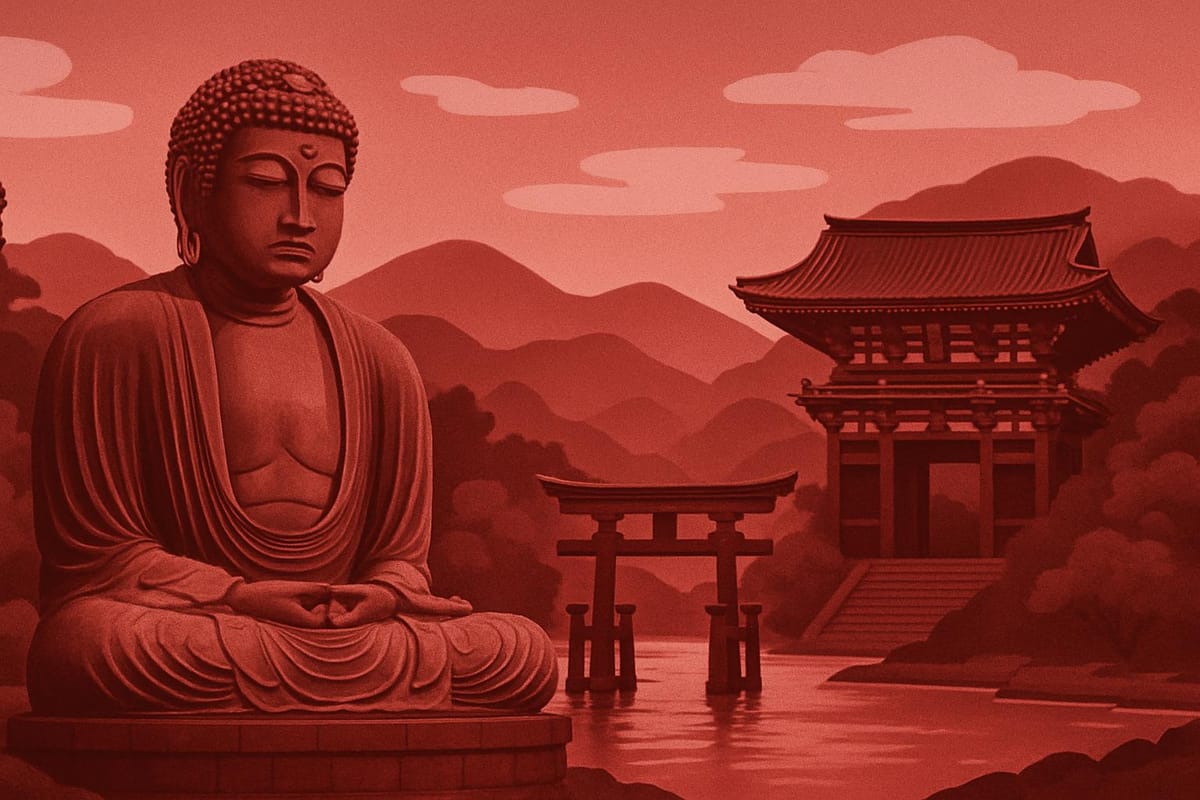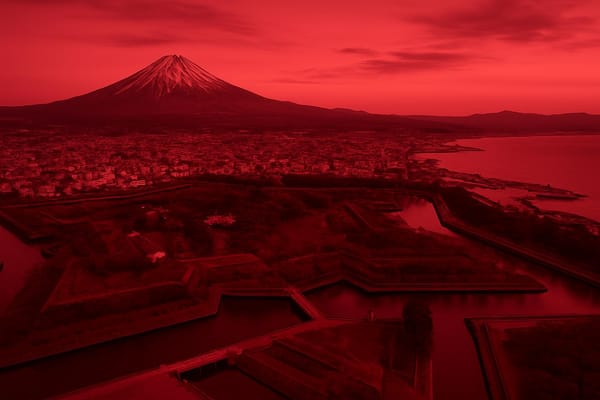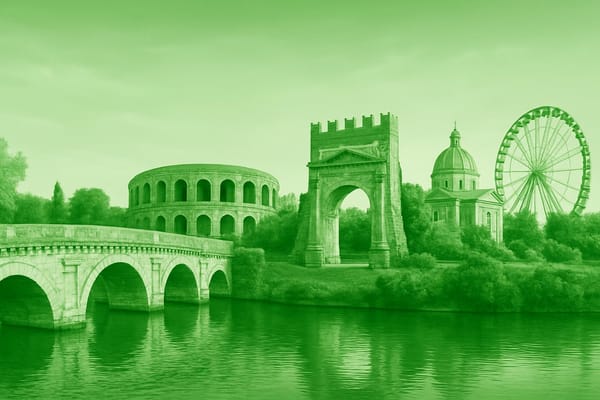Kamakura
Explore the Great Buddha, Zen temples, historic shrines, beaches & scenic hiking trails.

Important things to know about Kamakura
Kamakura is a compact, coastal city in Japan where modern life and layered history coexist within narrow streets and green valleys, offering a calm yet vibrant urban rhythm that contrasts with the nearby bustle of greater Tokyo; once the seat of a medieval shogunate, its identity is shaped by centuries of cultural development, a strong sense of local community, and an urban fabric that mixes traditional wooden houses and quiet residential neighborhoods with low-rise cafes, artisanal shops and creative studios, all framed by forested hills and a short stretch of shoreline that influence the city’s climate and lifestyle. Residents and visitors notice the gentle seasonal shifts-humid, leafy summers, a profusion of autumn color, and mild winters-reflected in local markets, food culture focused on fresh coastal ingredients, and a calendar of neighborhood festivals and craft traditions that keep local customs alive. The city’s transport links and commuter connections to Tokyo make it both a retreat and a lived-in suburb, attracting artisans, students, and families who value a slower pace, walkable streets and a pronounced sense of place; small-scale urban planning preserves pockets of greenery and low-density housing while fostering small businesses, galleries and restaurants that emphasize quality and sustainability. Whether described for its historical resonance, its natural setting between sea and hill, or its contemporary everyday life, Kamakura stands out in Japan as a city where heritage, nature, and community intersect to create a distinctive, human-scale environment that feels both timeless and rooted in present-day local rhythms.
Sightseeing hot-spots in Kamakura
Kamakura, Japan, is a compact treasure trove of history and coastal charm, where every corner seems to whisper stories of the samurai era. The city's crown jewel is the Great Buddha (Daibutsu) at Kotoku-in, an iconic bronze statue that draws visitors seeking both photography and cultural insight. Strolling from the station, you can also encounter the atmospheric lanes of Komachi-dori, filled with traditional sweets, crafts and cafés that make Kamakura sightseeing as much about culinary discovery as about temples. For anyone researching Kamakura attractions, these classic stops are essential.
Beyond the Daibutsu, Kamakura’s religious heritage unfolds across a network of serene temples and shrines. Tsurugaoka Hachimangu dominates the cultural landscape with seasonal festivals and a commanding approach, while Hasedera offers sweeping coastal views and a famous statue of Kannon surrounded by hydrangeas in summer. Zen temples like Kencho-ji and Engaku-ji provide quiet spaces for reflection and exemplify Kamakura Japan’s spiritual architecture. Lesser-known gems such as Zeniarai Benzaiten, where visitors wash coins for luck, add layer upon layer to the rich tapestry of Kamakura temples and traditions.
Nature and outdoor activities complement the historical sites, making Kamakura an ideal day trip or short stay. The Yuigahama Beach invites sunset walks and surfing, and the well-marked Daibutsu Trail links shrines through shaded hills, offering hikers panoramas of the sea and city. For those planning a broader itinerary, nearby Enoshima and the Shonan coast extend opportunities for seafood, scenic rail rides, and island exploration. Combining cultural landmarks, seaside leisure, and hiking, Kamakura remains one of the most rewarding destinations for travelers seeking authentic Kamakura sightseeing experiences in Japan.
Hotels to enjoy in Kamakura
Kamakura welcomes travelers with a varied selection of Kamakura hotels that blend seaside relaxation and rich cultural immersion. Whether you search for hotels in Kamakura with modern comfort or a charming ryokan experience, this historic coastal city offers options within easy reach of famous temples and the iconic Great Buddha. Many properties capitalize on their location, providing ocean views, peaceful garden settings, or boutique interiors that echo traditional Japanese aesthetics. Staying near the shore gives quick access to the beach, coastal walks toward Enoshima, and sunset vistas that make for memorable evenings. Boutique and family-run accommodations emphasize personalized service and local flavor, from handmade breakfast dishes to curated walking routes that reveal quieter shrines and hidden cafés away from the main tourist trails.
Travelers choosing from the wide range of hotels in Kamakura will find excellent transport links to Tokyo and Yokohama, with frequent trains making day trips convenient while allowing for a slower-paced overnight stay to explore at leisure. Many visitors prioritize hotels in Kamakura near Kamakura Station or those advertising easy access to bus routes for temple circuits, but staying closer to the waterfront suits those seeking seaside relaxation and surf culture. Seasonal draws such as cherry blossom viewing in spring and autumn leaves color the city, so booking ahead for peak times is wise. From boutique hotels with designer touches to a traditional ryokan offering tatami rooms and hot baths, Kamakura’s accommodations cater to photographers, history lovers, and beachgoers alike, making it a balanced destination for cultural exploration and coastal respite.
Restaurants to try in Kamakura
Kamakura is a historic coastal city whose restaurants of Kamakura blend seaside freshness with centuries-old culinary traditions, making it a must-visit for food lovers. Strolling down Komachi-dori or exploring lanes near Tsurugaoka Hachimangu reveals a range of dining options from cozy noodle shops to refined kaiseki houses, each showcasing seasonal produce and meticulous presentation. Many Kamakura restaurants specialize in local seafood, especially the delicate shirasu served over rice or in tempura, while other spots highlight robust ramen bowls, fresh sashimi and wood-fired grills. Visitors looking for authentic Japanese cuisine can find intimate eateries where chefs prepare tasting menus that reflect the rhythms of the nearby sea and mountains, and cafés offering matcha sweets and light bento fare provide perfect stops between sightseeing at the Great Buddha and temple gardens.
Search-savvy travelers often look for the best Kamakura restaurants that combine atmosphere with quality, whether that’s a seaside terrace with an expansive sea view or a tucked-away tavern favored by locals. Dining in Kamakura is not just about food but about place: a quiet izakaya after sunset, a bustling lunch counter near the station, or a refined tea-house where presentation is part of the experience all contribute to the city’s culinary identity. For anyone planning a trip, targeting keywords like Kamakura dining, restaurants in Kamakura, and Kamakura seafood will help locate options that suit budgets and tastes, from casual snacks to celebratory multi-course meals that express the region’s seasonal bounty.
Best shopping stops in Kamakura
Kamakura is a charming coastal city where shopping blends seamlessly with history and temple visits, making it a must-stop for travelers seeking unique finds. Strolling down Komachi-dori, the main Kamakura shopping street, you’ll encounter an inviting mix of boutiques, food stalls, and specialty stores selling Kamakura souvenirs like handmade ceramics, traditional textiles, and delicate Japanese sweets. The area around Tsurugaoka Hachimangu and the approach to the Great Buddha offers more than tourist trinkets; look for artisan shops that carry local crafts, incense, and accessories created by independent designers-perfect for those wondering what to buy in Kamakura. Seasonal markets and small galleries often showcase limited-edition pieces, while vintage and antique shops tucked away on quieter lanes appeal to collectors searching for authentic Japanese finds.
Beyond Komachi-dori, the backstreets of Kamakura reveal hidden gems from chic fashion boutiques to cozy tea shops offering hand-blended leaves and wagashi. Food lovers will appreciate the vibrant street food scene, where you can sample freshly made senbei, mochi, and savory skewers as you explore. For a memorable shopping experience, combine temple sightseeing with browsing at local galleries and craft fairs, where you’ll find artisanal jewelry, woodwork, and paper goods that reflect Kamakura’s blend of traditional and modern aesthetics. Whether hunting for the perfect souvenir or discovering a one-of-a-kind piece, Kamakura shopping promises a blend of culture, flavor, and design that captures the essence of this historic city.
Nightlife highlights in Kamakura
Kamakura nightlife blends historic charm with intimate modern hangouts, creating an appealing scene for both locals and visitors. Strolling from Kamakura Station down Komachi-dori, you’ll find cozy izakaya, craft beer bars, and cocktail lounges that emphasize seasonal ingredients and relaxed conversation. As lanterns glow and shopfronts dim, the town’s narrow streets reveal snug spots for yakitori, sushi and late-night ramen - perfect for sampling authentic flavors after an evening of temple views. The atmosphere is less frenetic than Tokyo but rich in character, with softly lit shrines and the silhouettes of ancient structures offering a serene backdrop to a night out.
For those seeking music and ocean breezes, the nightlife extends toward Yuigahama Beach and nearby Enoshima, where seaside bars and occasional live performances bring a laid-back festival vibe to warm months. Intimate venues in Kamakura host live music, jazz nights and open-mic events, while tiny cocktail bars showcase local spirits and inventive mixes. The town’s compact size makes hopping between a traditional izakaya and a modern craft beer spot effortless, and its proximity to Tokyo makes Kamakura nightlife an ideal choice for a memorable evening escape.
Getting around in Kamakura
Kamakura's airport and train access is straightforward for travelers: from Haneda Airport it's typically around 40–60 minutes by taking the Keikyu line to Shinagawa and transferring to the JR Yokosuka Line or Shonan-Shinjuku Line to Kamakura Station, while from Narita Airport the journey usually takes about 90–120 minutes using the Narita Express to Tokyo or Yokohama and then a JR connection; trains are frequent, reliable and form the backbone of Kamakura transportation, making it easy to plan day trips from Tokyo or Yokohama. Once at Kamakura Station, visitors can transfer to the charming Enoden (Enoshima Electric Railway) for a scenic coastal ride to Enoshima and Fujisawa or use local buses and taxis to reach temples like Hasedera and the Great Buddha; expect heavier crowds on weekends and during cherry blossom and autumn foliage seasons, and note that services such as luggage forwarding (takkyubin) and coin lockers at the station help with a seamless visit. For SEO-focused searches like "how to get to Kamakura from the airport" or "Kamakura train access," emphasize connections via Haneda, Narita, JR lines and the Enoden for clear, traveler-friendly guidance.
Culture must-see's in Kamakura
Kamakura’s rich cultural tapestry is woven from its historic role as a medieval capital and its concentration of ancient temples and shrines that continue to shape local life. Visitors are drawn to the iconic Great Buddha (Daibutsu) at Kōtoku-in and the grand approach of Tsurugaoka Hachimangu, while quieter Zen temples like Kenchō-ji and Engaku-ji offer meditation gardens and ritual architecture that reveal the city’s Buddhist influence. The legacy of the samurai shogunate lingers in stone pathways and carved gates, and the narrow lanes around Komachi-dori hum with traditional craft shops and eateries. Seasonal festivals-from the spring Kamakura Matsuri parades to autumn shrine rituals-create moments when centuries-old customs become living pageantry, ideal for anyone researching Kamakura culture, historical attractions, or authentic Japanese heritage.
Beyond monuments, Kamakura’s cultural highlights include immersive experiences that connect visitors with everyday tradition: tea ceremonies in tatami rooms, contemplative strolls through ancient cemetery slopes, and craft demonstrations of Kamakura-bori lacquerwork and local pottery. The coastal setting blends temple calm with seaside leisure, where cliffside walks, bamboo groves and small museums foster an atmosphere of creative serenity. Food culture-shōyu-based dishes, matcha sweets and fresh seafood-complements temple visits, and local guides often tailor itineraries for those seeking depth in Buddhist practice, samurai history, or artisanal crafts. For travelers and cultural researchers alike, Kamakura offers a concentrated, walkable window into Japan’s past and present, making it a prime destination for those optimizing searches for Kamakura attractions, traditional Japanese culture, and Zen heritage.
History of Kamakura
Kamakura history is rooted in the dramatic shift of power that transformed Japan from courtly aristocracy to a warrior-led polity, and the city's story begins most notably with Minamoto no Yoritomo establishing a military government in the late 12th century. After the Genpei War (1180–1185) consolidated Minamoto dominance, Yoritomo chose Kamakura as his seat of power, inaugurating the Kamakura period and the first true shogunate in Japanese history. This emergence of samurai rule restructured political life, law, and landholding systems, making Kamakura a bustling administrative and military center distinct from the imperial court in Kyoto. The era is also marked by resilience and conflict, from internal power struggles among regents to external challenges such as the Mongol invasions of the late 13th century, which tested the fortifications and resolve of the city and its warriors. Even after the fall of the Kamakura regime in 1333, when forces loyal to Emperor Go-Daigo and commanders like Nitta Yoshisada breached Kamakura’s defenses, the legacy of governance, martial culture, and military institutions established there continued to influence Japanese statecraft for centuries.
Beyond politics, Kamakura evolved into an enduring cultural and religious hub whose temples and shrines attract scholars, pilgrims, and tourists alike. The city became a fertile ground for Zen Buddhism, which deeply influenced samurai aesthetics, philosophy, and arts - a transformation visible in the austere beauty of Engaku-ji, Kencho-ji, and the coastal temple of Hasedera. Perhaps the most iconic symbol is the Great Buddha (Daibutsu) of Kotoku-in, a monumental bronze statue that epitomizes Kamakura’s spiritual and artistic achievements and remains a major draw for visitors exploring Kamakura city today. The concentration of historic sites like Tsurugaoka Hachimangu alongside well-preserved streets and seaside landscapes has kept Kamakura relevant as a living museum of medieval Japan, where the confluence of religion, art, and samurai tradition can still be experienced. For anyone researching Kamakura history, these layers of political innovation and cultural flourishing explain why the city is both a vital chapter in Japan’s past and a compelling destination for cultural tourism.



